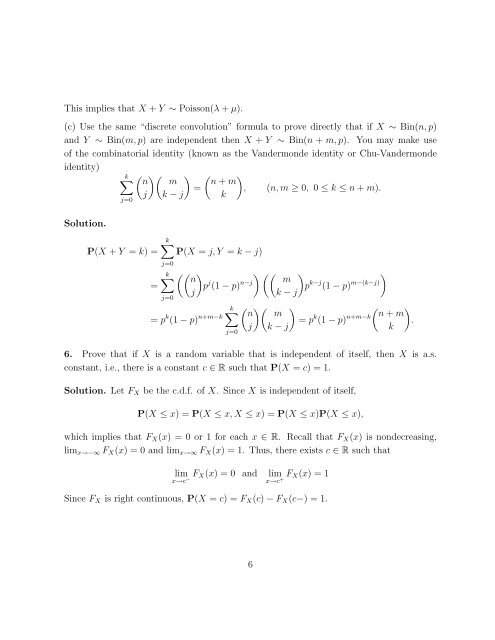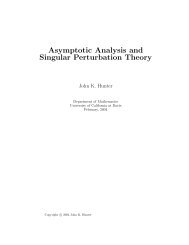Solutions to Homework Set No. 4 – Probability Theory (235A), Fall ...
Solutions to Homework Set No. 4 – Probability Theory (235A), Fall ...
Solutions to Homework Set No. 4 – Probability Theory (235A), Fall ...
Create successful ePaper yourself
Turn your PDF publications into a flip-book with our unique Google optimized e-Paper software.
This implies that X + Y ∼ Poisson(λ + µ).<br />
(c) Use the same “discrete convolution” formula <strong>to</strong> prove directly that if X ∼ Bin(n, p)<br />
and Y ∼ Bin(m, p) are independent then X + Y ∼ Bin(n + m, p). You may make use<br />
of the combina<strong>to</strong>rial identity (known as the Vandermonde identity or Chu-Vandermonde<br />
identity)<br />
Solution.<br />
k<br />
j=0<br />
P(X + Y = k) =<br />
<br />
n m<br />
=<br />
j k − j<br />
n + m<br />
k<br />
P(X = j, Y = k − j)<br />
k<br />
<br />
, (n, m ≥ 0, 0 ≤ k ≤ n + m).<br />
j=0<br />
k<br />
<br />
n<br />
= p<br />
j<br />
j=0<br />
j (1 − p) n−j<br />
<br />
m<br />
p<br />
k − j<br />
k−j (1 − p) m−(k−j)<br />
<br />
= p k (1 − p) n+m−k<br />
k<br />
<br />
n m<br />
= p<br />
j k − j<br />
j=0<br />
k (1 − p) n+m−k<br />
n + m<br />
6. Prove that if X is a random variable that is independent of itself, then X is a.s.<br />
constant, i.e., there is a constant c ∈ R such that P(X = c) = 1.<br />
Solution. Let FX be the c.d.f. of X. Since X is independent of itself,<br />
P(X ≤ x) = P(X ≤ x, X ≤ x) = P(X ≤ x)P(X ≤ x),<br />
which implies that FX(x) = 0 or 1 for each x ∈ R. Recall that FX(x) is nondecreasing,<br />
limx→−∞ FX(x) = 0 and limx→∞ FX(x) = 1. Thus, there exists c ∈ R such that<br />
lim<br />
x→c− FX(x) = 0 and lim<br />
x→c + FX(x) = 1<br />
Since FX is right continuous, P(X = c) = FX(c) − FX(c−) = 1.<br />
6<br />
k<br />
<br />
.
















